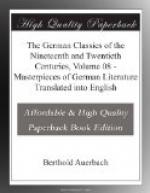The most original of all the original people in those days ended up as caricatures. The Rococo is the conscious humor of the Pigtail; for that reason it can still be used artistically today, whereas the Pigtail, which is totally lacking in the humor of self-knowledge, has long been artistically dead. Even today when a genre-painter wishes to paint real lifelike caricatures he paints them in Rococo costume. Hasenclever’s Hieronymus Jobs, for example, would appear to us absolutely exaggerated, if the figures in these pictures did not wear pigtails and wigs. Only in this unique age of the Rococo does it seem to us possible that such freaks could have walked the earth in the flesh. And we are not wrong in so thinking; for the mania to be an original type, a virtuoso of personality, in that day turned innumerable persons into genuine caricatures. A certain Count von Hoditz, in the middle of the eighteenth century, founded a so-called “Maria Theresa sheep-farm” (in honor of the Empress) on his estate Roswalde, in Silesia, and here his subjects and villeins had to play at Greece and Rome, year in and year out. Temples were erected to Thetis, Diana, Flora, etc., and peasants went about dressed up as haruspices and augurs. The Pontifex slaughtered a sheep on the sacrificial altar, the oracle was consulted in a cave, and in a temple dedicated to the sun young priests kept up an ever-flaming fire. On this estate an actor was master of the hunt, librarian, theatre director, high priest of the sun and—schoolmaster, all in his own person; and Frederick the Great was so pleased with the Silesian Arcadia that he celebrated it in a poetic epistle. If one tried nowadays to give an accurate description of this bare reality in a novel it would look like the most exaggerated caricature. The Rococo, however, can bear the strongest laying on of color and the most distorted forms. It was not without some reason that, in those days, they loved to chisel or carve on every house door and on the neck of every violin a hideous face which is making grimaces and sticking out its tongue. Many of the figures in Moliere’s and Holberg’s comedies, and in the innumerable farces written in imitation of them in the eighteenth century, now appear to us clumsy, extravagant caricatures. But if we recall such historical phenomena as the above-mentioned Maria Theresa sheep-farm, we will find that for their age the clumsy figures were well portrayed characteristic types, far rather than caricatures. In them is mirrored the unmanageable eccentricity of the more original persons in the Pigtail age, so abounding in constraint and training.




